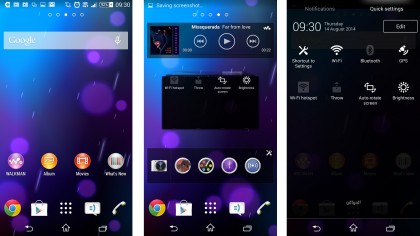Why you can trust TechRadar
The Sony Xperia T3 doesn't let you get near its battery. It's sealed behind the back plate.
However, I do know it's a 2500mAh unit. That's a good deal smaller than the similarly sized Xperia Z2's 3200mAh, but then this phone also uses a lower screen resolution.
I didn't find that it all balanced out perfectly, though. Battery performance is less than perfect in the Xperia T3.
In TechRadar's usual battery test, a 90-minute 720p video playback where the screen is set to maximum brightness, the phone lost a hefty 27% of charge. That means when left to play video, it'll only last for around five and a half hours.

It's not a great result. However, it was in normal use that I really got the measure of the Xperia T3. It's simply a bit too easy to run down in a day, and as battery level drops off pretty swiftly in the final 10% rather than clinging onto every digit like some other phones, it just doesn't give you the security of the best.
The most obvious reasons for this include that the battery is not gargantuan, that the screen is quite a drain and tends to be fairly generous with its brightness level, and that the Snapdragon 400 doesn't quite have the same efficiency as the Snapdragon 800 chipset.
As usual, though, Sony does provide some ways to make up the difference itself, with power-saving modes. In my tests I used the standard battery mode with only queuing of background data enabled. This doesn't stop apps from accessing background data, but organises them into batches so the mobile internet connection isn't working in drips and drops 24/7.
Sign up for breaking news, reviews, opinion, top tech deals, and more.
There are three extra modes – stamina, low-battery and location-based Wi-Fi. Stamina mode claims to just-about double stamina by restricting performance and apps' access to background data.
Low-battery mode is an even more severe battery-saver for when charge level gets low. Location-based Wi-Fi automatically switches Wi-Fi on and off depending on whether the area you're in has any saved Wi-Fi networks or not.
Stamina mode effectively stops the battery dead when you're not using the phone. So while the Sony Xperia T3 doesn't last all that long going full pelt, there are more than enough ways to manage the phone's performance to improve longevity.
The phone doesn't help itself in other ways, though. For example, the vibration feedback motor is far too strong, sounding like the revving engine of a tiny little car should you have it set to go off when you press a key on the keyboard (it's set to do this by default). This eats up battery, not to mention feeling so weird I turned it off.

The Sony Xperia T3 also gets quite hot when searching for a mobile internet signal, much like the Xperia Z2. We never received any overheating error messages, but as with other Xperias the extra heat seems to be a result of trying to make the phone as slim as it is.
The hot zone is up at the top of the phone, where its brains sit, rather than directly under your hand, but you do still notice it getting toasty at times.
Coming back to the basics, call quality is perfectly good. Top-end clarity seemed a little worse than the Xperia Z2, speaking from memory, but top volume is decent and the call speaker has a good, robust tone.

Andrew is a freelance journalist and has been writing and editing for some of the UK's top tech and lifestyle publications including TrustedReviews, Stuff, T3, TechRadar, Lifehacker and others.
